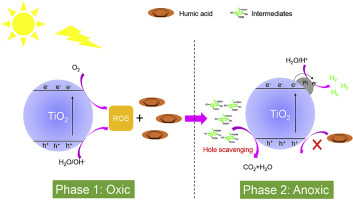Water Research ( IF 12.8 ) Pub Date : 2020-03-05 , DOI: 10.1016/j.watres.2020.115684 Guocheng Huang , Zhengtao Xiao , Weiqian Zhen , Yaxin Fan , Cuiping Zeng , Chuanhao Li , Shengwei Liu , Po Keung Wong

|
Photocatalysis provides a “green” strategy to produce the clean energy of H2. However, the realization of efficient H2 production is usually accomplished by the consumption of electron donors, which are costly energy carriers themselves. Here, we attempted to utilize the naturally abundant humic acid (HA), a representative natural organic matter (NOM), as the source of electron donor in a cascading oxic-anoxic photocatalytic system. Results showed that degradation of HA and remarkable H2 yield (1660.9 μmol g−1 h−1 at optimal condition) were obtained successively, whereas the anoxic photocatalytic treatment of pristine HA did not improve H2 yield but substantially eliminated the H2 production and HA degradation efficiency. These phenomena suggested the preoxidation process plays a vital role in counteracting the detrimental effect of HA on photocatalytic H2 production. Electrochemical measurement indicated that the preoxidized HA harbored more redox-active moieties than the untreated HA and thus leading to a higher photo-induced charge carrier separation efficiency. A variety of advanced spectroscopic analyses revealed that the photocatalytic oxic pre-treatment resulted in breakdown of chemically inert, electron mediating and chromophoric aromatic macrostructure of HA to form smaller sized oxygenated organic intermediates. These intermediates were more nucleophilic than the pristine HA and acted as sacrificial reagent in the subsequent anoxic process for boosting H2 production. This study showcases an energy recovering water remediation process and paves the way for the design of novel photocatalytic technologies for environmental application.
中文翻译:

通过级联的氧-缺氧光催化过程从天然有机物制氢:能量回收净水技术
光催化为产生H 2的清洁能源提供了一种“绿色”策略。然而,通常通过消耗电子供体(其本身是昂贵的能量载体)来实现有效H 2生产的实现。在这里,我们尝试利用天然富集的腐殖酸(HA)(一种代表性的天然有机物(NOM))作为级联的氧-缺氧光催化系统中的电子供体来源。结果表明,相继获得了HA的降解和显着的H 2产量(最佳条件下为1660.9μmolg -1 h -1),而原始HA的缺氧光催化处理并没有提高H 2的产量,但基本消除了H2生产和HA降解效率高。这些现象表明,预氧化过程在抵消HA对光催化H 2产生的有害作用中起着至关重要的作用。电化学测量表明,预氧化的HA比未处理的HA具有更多的氧化还原活性部分,从而导致更高的光诱导电荷载流子分离效率。各种高级光谱分析表明,光催化氧化预处理导致HA的化学惰性,电子介导和发色性芳香族宏观结构分解,从而形成较小尺寸的氧化有机中间体。这些中间体比原始的HA更具亲核性,并在随后的缺氧过程中充当牺牲剂来增强H2生产。这项研究展示了一种能量回收水修复工艺,并为设计用于环境应用的新型光催化技术铺平了道路。


























 京公网安备 11010802027423号
京公网安备 11010802027423号